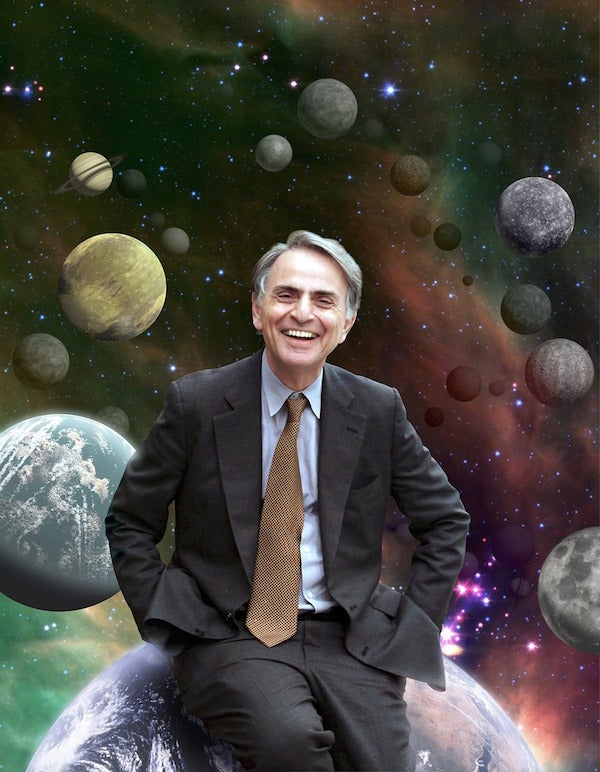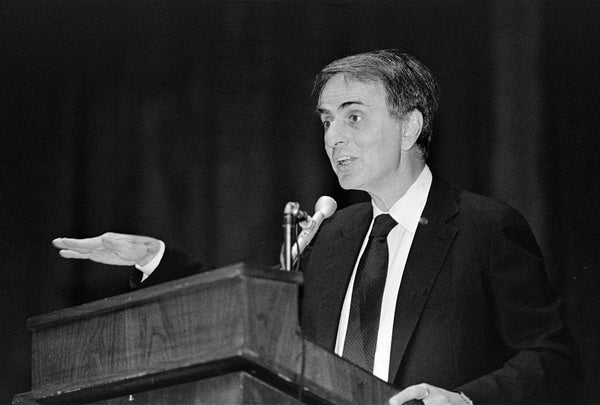This article was published in Scientific American’s former blog network and reflects the views of the author, not necessarily those of Scientific American
It has been twenty years since astronomer Carl Sagan’s death on December 20, 1996. Sagan was a planetary scientist of the first rank, with tremendous gifts for public speaking and popular writing. He used these gifts not only to advocate for the importance and excitement of science, but also for the centrality of reason, the settling of disagreements where possible by appeals to evidence, and the essential similarity of humans across ethnic divides. His greatest commitments today stand in stark antithesis to the worst of the current national and world situation.
Carl Sagan made key contributions to our understanding of the Solar System and Earth within it. Perhaps most important was his recognition, with George Mullen, of the “early faint Sun paradox”: if our Sun had evolved like a typical G-class star—the conservative assumption—then its luminosity would have been lower in the past. This in turn means that prior to about 2 billion years ago, Earth would have been too cold for our current greenhouse atmosphere to have kept surface temperatures high enough for liquid water—in contradiction to abundant evidence. The problem gets more severe the further back in time one goes, posing a challenge for our understanding of the origin of life. Earth’s early atmosphere therefore presumably provided a much more powerful greenhouse than is the case today, and understanding whether and why this was the case became a major topic within the geosciences.
Sagan is perhaps most associated with speculations about, and the scientific search for, extraterrestrial life—what the Nobel prize-winning biologist Joshua Lederberg had called "exobiology." After the Viking landers’ failure to find life on Mars in 1976—or, worse, the landers’ seemingly ambiguous answer to this question—exobiology fell out of favor in planetary science. A decade after Viking, Sagan maintained one of the few groups that was still addressing the question seriously, through laboratory organic chemistry and the use of spacecraft data.
On supporting science journalism
If you're enjoying this article, consider supporting our award-winning journalism by subscribing. By purchasing a subscription you are helping to ensure the future of impactful stories about the discoveries and ideas shaping our world today.
In the mid-1980s, Sagan’s group’s experiments suggesting that organics should be copiously produced by radiation chemistry in the outer solar system led to harsh exchanges at national meetings. Yet now, after spacecraft missions to comets and more extensive exploration of the outer solar system, the near-ubiquitous presence of organics is viewed as unremarkable, even obvious. (“Organic” simply refers to molecules that contain carbon bound with hydrogen and possibly nitrogen or other atoms; life as we know it is based on organic molecules, but the term carries no necessary connotation of biology.)
Together with growing evidence for liquid water environments throughout the Solar System, Sagan’s insistence on the importance of knowing whether there are other nearby examples of life became a main driver for solar system exploration. What is now called “astrobiology” is today a discipline at the heart of NASA’s mission. Sagan lived to see this transformation take place in the 1990s.
Yet for all Sagan’s well-known enthusiasm for the possibility of life elsewhere, his scientific research repeatedly had the effect of making the prospects for life in our solar system seem less likely. His early work on Venus’ greenhouse atmosphere destroyed any picture of that planet’s surface as an abode of life, and Sagan’s publications made this point explicit. His work with his student Jim Pollack on the seasonal “wave of darkening” on Mars showed that what some scientists had interpreted as an effect of seasonal vegetation was instead convincingly explained by the deposition of dust by annual dust storms. And his early faint Sun paradox made the origin of life on Earth seem even more mysterious.
It is striking that many of Sagan’s scientific results undercut his personal hopes for life in our solar system. But this was consistent with his insistence on skepticism as a component of the scientific process—and indeed, as a necessary part of our political lives. Sagan taught an undergraduate course in “critical thinking” for many years, and up until the end of his life he was a skeptic—a skeptic with no patience for misogyny or racism.

Credit: Skeeze Pixabay
Sagan’s gift for sharing this basic principle of science with a general audience was extraordinary. He was a master at popular writing and public speaking—both on his own and then, in the last two decades of his career, in partnership with the writer Ann Druyan, who became his wife. Cosmos, the book accompanying their wildly successful television series, appears to have been the best-selling science book in the English language up to its time.
Over and again I have heard scientists of my generation tell of how important one or another of his books had been for them as adolescents trying to choose their path. One leading planetary scientist recalls that she read Intelligent Life in the Universe, Sagan’s book with the Soviet astronomer I. S. Shklovskii, in one fascinated marathon. A leading cometary scientist tells of reading The Cosmic Connection as a boy and feeling that “I had never encountered a book like this before. Was it poetry? An art book? And yet it referenced organic chemistry and astrophysics. But . . . a chapter called `The Night Freight to the Stars’ read more like Ray Bradbury.” Yet a third scientist recalls coming across a conference proceedings Sagan had edited, Communication with Extraterrestrial Intelligence, and being riveted by the idea that a scientific career could be a pathway to becoming a credible part of such remarkable discussions.
But Sagan’s extraordinary success in reaching the public, and with it policymakers, drew regular disparagement from many other scientists. When I arrived at Cornell in 1985—having gone there specifically to work with Carl—one senior faculty member took me aside and told me that taking Carl’s graduate seminar on scientific results from the outer solar system would be a waste of my time. Yet it, and a subsequent graduate seminar Carl offered on the origins of life, were among the very best college or university courses I had ever taken, demonstrating both Carl’s command of the literature as well as his signature ability to use fundamental physics and chemistry to rapidly rule out, or in, novel hypotheses.
At national meetings I would too often hear other astronomers disparaging him, but as Carl once matter-of-factly commented to me, these same people would contact him for his help when their spacecraft mission was in trouble with Congress. And he would invariably try to help, because of the importance of the science. Worst perhaps was the internal (and supposedly confidential) debate in which the National Academy of Science voted to deny Sagan membership. Reports that leaked to the press made clear that Sagan’s opponents felt the greatest contempt for his popularization of science.
I sometimes wonder whether any of these individuals now draw lines between their treatment of science’s leading popular writer and spokesperson and the status of science in our contemporary public and political life.
Carl emphasized how hard-fought the advances of human civilization had been, how our progress should not be taken for granted. He foresaw the appeal and danger of backward steps. In one of his last books, The Demon-Haunted World, he included this warning:
"We’ve arranged a global civilization in which most crucial elements profoundly depend on science and technology. We have also arranged things so that almost no one understands science and technology. This is a prescription for disaster. . . .
I worry that . . . pseudoscience and superstition will seem year by year more tempting, the siren song of unreason more sonorous and attractive. Where have we heard it before? Whenever our ethnic or national prejudices are aroused, in times of scarcity, during challenges to national self-esteem or nerve . . . or when fanaticism is bubbling up around us—then, habits of thought familiar from ages past reach for the controls.
The candle flame gutters. Its little pool of light trembles. Darkness gathers. The demons begin to stir."
